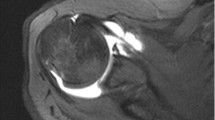Abstract
Purpose
A clinical augmented reality guidance system was developed for MRI-guided musculoskeletal interventions Magnetic Resonance Image Overlay System (MR-IOS). The purpose of this study was to assess MRI compatibility, system accuracy, technical efficacy, and operator performance of the MR-IOS.
Methods and materials
The impact of the MR-IOS on the MR environment was assessed by measuring image quality with signal-to-noise ratio (SNR) and signal intensity uniformity with the system in various on/off states. The system accuracy was assessed with an in-room preclinical experiment by performing 62 needle insertions on a spine phantom by an expert operator measuring entry, depth, angle, and target errors. Technical efficacy and operator performance were tested in laboratory by running an experiment with 40 novice operators (20 using freehand technique versus 20 MR-IOS-guided) with each operator inserting 10 needles into a geometric phantom. Technical efficacy was measured by comparing the success rates of needle insertions between the two operator groups. Operator performance was assessed by comparing total procedure times, total needle path distance, presumed tissue damage, and speed of individual insertions between the two operator groups.
Results
The MR-IOS maximally altered SNR by 2% with no perceptible change in image quality or uniformity. Accuracy assessment showed mean entry error of 1.6 ± 0.6 mm, depth error of 0.7 ± 0.5 mm, angle error of 1.5 ± 1.1°, and target error of 1.9 ± 0.8 mm. Technical efficacy showed a statistically significant difference (p = 0.031) between success rates (freehand 35.0% vs. MR-IOS 80.95%). Operator performance showed: mean total procedure time of 40.3 ± 4.4 (s) for freehand and 37.0 ± 3.7 (s) for MR-IOS (p = 0.584), needle path distances of 152.6 ± 15.0 mm for freehand and 116.9 ± 8.7 mm for MR-IOS (p = 0.074), presumed tissue damage of 7,417.2 ± 955.6 mm2 for freehand and 6062.2 ± 678.5 mm2 for MR-IOS (p = 0.347), and speed of insertion 5.9 ± 0.4 mm/s for freehand and 4.3 ± 0.3 mm/s for MR-IOS (p = 0.003).
Conclusion
The MR-IOS is compatible within a clinical MR imaging environment, accurate for needle placement, technically efficacious, and improves operator performance over the unassisted insertion technique. The MR-IOS was found to be suitable for further testing in a clinical setting.
Similar content being viewed by others
References
Fischer GS, Deguet A, Csoma C, Taylor RH, Fayad LM, Carrino JA, Zinreich SJ, Fichtinger G (2007) MRI image overlay: application to arthrography needle insertion. J Comput Assis Surg JCAS 12(1): 2–14
Fischer GS, Deguet A, Csoma C, Taylor RH, Fayad L, Zinreich SJ, Fichtinger G (2006) Musculoskeletal needle placement with MRI image overlay guidance. International society for computer assisted orthopaedic surgery 6th annual conference—CAOS 2006, Montreal, pp 158–160
Fischer GS, Dyer E, Csoma C, Deguet A, Fichtinger G (2007) Validation system of MRI image overlay and other insertion techniques. Studies in health technology and informatics—medicine meets virtual reality. In vivo, In vitro, In silico: Designing the Next in Medicine 15(125): 130–135
Fritz J, U-Thainual P, Ungi T, Flammang AJ, Cho NB, Fichtinger G, Iordachita I, Carrino JA (2012) Augmented reality visualization using image-overlay for MR-Guided interventions: accuracy for lumbar spinal procedures with a 1.5 Tesla MRI scanner. Am J Roentgenol 198(3): W266–W273
Fritz J, U-Thainual P, Ungi T, Flammang AJ, Cho NB, Fichtinger G, Iordachita I, Carrino JA (2011) Augmented reality visualization using image-overlay for MR-guided interventions: assessment of performance in cadaveric shoulder and hip arthrography. RSNA 97th Scientific Assembly and Annual Meeting
U-Thainual P, Fischer G, Iordachita I, Vikal S, Fichtinger G (2009) The Perk Station: systems design for percutaneous intervention training suite. In: Proceedings IEEE international conference on robotics and biomimetics ROBIO 2009, Bangkok, pp 1693–1697, 22–25 Feb, 2009
Vikal S, U-Thainual P, Carrino JA, Iordachita I, Fischer GS, Fichtinger G (2010) Perk Station: percutaneous surgery training and performance measurement platform. Comput Med Imaging Graph 34(1): 19–32
Wood BJ, Zhang H, Durrani A, Glossop N, Ranjan S, Lindisch D (2005) Navigation with electromagnetic tracking for interventional radiology procedures: a feasibility study. J Vasc Interv Radiol 16(4): 493–505
NEMA (2008) Determination of signal-to-noise ratio (SNR) in diagnostic magnetic resonance imaging, NEMA Standard Publication MS 1-2008. The association of electrical and medical imaging equipment manufacturers, 2008. http://www.nema.org/stds/ms1.cfm
Howell DC (2007) Statistical methods for psychology, 7th edn. Cengage Learning, Wadsworth
Fritz J, U-Thainual P, Ungi T, Flammang AJ, Cho N, Fichtinger G, Iordachita I, Carrino JA (2012) Augmented reality visualization with image overlay for MRI-guided intervention: accuracy for lumber spinal procedures with a 1.5-T MRI System. AJR 198:W266-W273. doi:10.2214/AJR.11.6918
Yeo CT, Ungi T, U-Thainual P, Lasso A, McGraw RC, Fichtinger G (2011) The effect of augmented reality training on percutaneous needle placement in spinal facet joint injections. IEEE Trans Biomed Eng 58(7): 2013–2037
Fischer GS, Weiss CR, Dyer E, Csoma C, Deguet A, Carrino JA, Fichtinger G (2007) Evaluation of MR image overlay for spinal interventions. International society for magnetic resonance in medicine 15th scientific meeting—ISMRM 2006, Berlin, May 2007
http://www.fda.gov/MedicalDevices/DeviceRegulationandGuidance/GuidanceDocuments/ucm107721.htm
Author information
Authors and Affiliations
Corresponding author
Rights and permissions
About this article
Cite this article
U-Thainual, P., Fritz, J., Moonjaita, C. et al. MR image overlay guidance: system evaluation for preclinical use. Int J CARS 8, 365–378 (2013). https://doi.org/10.1007/s11548-012-0788-0
Received:
Accepted:
Published:
Issue Date:
DOI: https://doi.org/10.1007/s11548-012-0788-0




